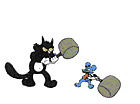Starting Points in Language
Study:
Proper pronunciation is a must for being
understood. If you have an accent, don't worry. Sometimes
they go away with time. And besides, ... there are so
many regional dialects, it's hard to keep up with native
speakers. But again: practice anyway! The more clearly
you speak, the better results you'll get in being understood.
For the sake of practice, really get
down on the numbers! Knowing these backwards and forward
can bring your pronunciation up to snuff. So visit the
Numbers
Page for extra practice.
When telling time, am
and pm
are stated by providing the part of the day the hour occurs.
For am,
add "de la mañana."
For pm,
add "de la tarde"
or "de la noche."
|

